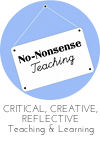Here are three reading tips to help children infer the theme (big ideas) in books:
Picture books today are amazing. Regardless of the age of the learner (yes, even Gr. 8's benefit greatly), picture books are an effective way to teach theme. When read aloud, learners have equal access to the text, they get the opportunity to stop and talk about their thinking and, the text is short enough to teach learners where important inferences have to be made. All too often, teachers move too quickly into using novels as read alouds. This leaves many children struggling to understand and remember where and how inferences were made, preventing them from understanding the big ideas. Novels can simply be too long for many children and, because of their length, do not provide enough opportunities for children to practice the reading skills required to understand theme.
2. Revisit the same picture book (read aloud) for a few days in a row.
How many times have you left a staff meeting or a conversation where hours later you came up with a great idea that should have been shared but the chance was lost? Teaching children to delve deeply into a text requires you to provide them the time and multiple opportunities to revisit similar conversations. Children need time to process their thinking. They also require time to connect deeply with the text and come to new insights. Providing wait time for children to answer questions about the text means more than allowing 30 seconds of thinking then responding. Our learners require a substantial amount of wait time to absorb the text, take on new thinking, listen to their peers, re-think again and continue to connect the meaning of the text with their own lives. To provide this opportunity for your learners, read the same picture book aloud for 3 - 5 days. Also consider the idea that since the average child requires revisiting of a text, it is absolutely essential for your learners with special needs. You don't have to read the entire text each time. Revisit important parts, ask children to add their thinking, comment and ask questions. Ask different questions yourself, word your questions differently, pair children with new turn and talk partners. Focus your questions on different big ideas in the text on separate days. Whatever you do, stop changing your read alouds daily and begin to stretch them out for a few days.
3. Cluster three or four picture books (read alouds) with similar themes.
When choosing your read alouds, choose three or four with similar themes and delve deeply into these themes over the course of a few weeks. To make the best use out of instructional time, integrate themes with content. For example; If you are teaching about plants, habitats, saving energy or recycling for science then picture books such as:
are all wonderful stories, each with a different author's message, but with similar themes about caring for - and the consequences of not caring for - the world around us. When you cluster such themes, you provide children the opportunity to experience similar, yet different big ideas. This gives learners a wider perspective, improved vocabulary, and a reasonable wait time to develop a deeper understanding about the subject.
Lesson plans, for how you might incorporate read alouds of these books into your teaching, are available at:
https://www.teacherspayteachers.com/Store/No-nonsense-Teaching
Great Kapok Tree Read Aloud, Curious Garden Read Aloud, Blackout Read Aloud, and Varmints Read Aloud.
https://www.teacherspayteachers.com/Store/No-nonsense-Teaching
Great Kapok Tree Read Aloud, Curious Garden Read Aloud, Blackout Read Aloud, and Varmints Read Aloud.



































1 comment:
I work on this with my little kids a lot. I hadn't thought of reading several books with similar themes in a row, though. Great idea. Thank you!
Post a Comment